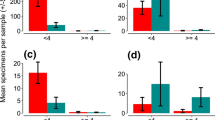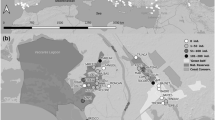Summary
The surface cover produced by aquatic macrophytes is the primary habitat for immature stages (eggs, larvae, and pupae) ofAnopheles mosquitoes. We hypothesized that both the abundance of immatureAnopheles and the recruitment ofAnopheles (from oviposition or larval movement) is positively related to the amount of surface cover present. Field sampling documented a positive correlation betweenAnopheles egg and larval abundance and the amount of vegetative cover present (measured as the number of emergent stems m-2) in monospecific beds ofMyriophyllum aquaticum in a California, USA, wetland. Experiments conducted to determine the influence ofMyriophyllum stem density on selection of oviposition sites by adultAnopheles females clearly indicate that oviposition rate (eggs m-2 d-1) increases as stem density increases from 0 to 1000 stems m-2 but decreases as stem density approaches 2000 stems m-2. In selecting microhabitats,Anopheles larvae preferred patches with high stem densities over patches with few or no plant stems; this preference correlates with differences in habitat quality (e.g., increased refuge from predation and enriched food sources). The optimal habitat for anopheline mosquitoes apparently occurs above a threshold plant density of approximately 500Myriophyllum stems m-2. Habitat heterogeneity produced by variability in the distribution and structure of aquatic vegetation strongly influences the local distribution and abundance of anopheline mosquitoes.
Similar content being viewed by others

References
Aitken THG (1945) Studies on the anopheline complex of Western America. U Calif Pub Entomol 7:273–364
Balling SS, Resh VH (1984) Seasonal patterns of pondweed standing crop andAnopheles occidentalis densities in Coyote Hills Marsh. Proc Calif Mosq Vector Contr Assoc 52:122–12
Bentley MD, McDaniel IN, Yatagai M, Lee HP, Maynard KR (1981) Oviposition attractants and stimulants ofAedes triseriatus (Say) (Diptera: Culicidae). Environ Entomol 10:186–189
Campbell JM, Clark WJ (1983) Effects of microhabitat heterogeneity on the spatial dispersion of small plant-associated invertebrates. Freshwat Invert Biol 2:180–185
Campbell JM, Clark WJ, Kosinski R (1982) A technique for examining microspatial distribution of Cladocera associated with shallow water macrophytes. Hydrobiologia 97:225–232
Cattaneo A, Kalff J (1979) Primary production of algae growing on natural and artifical aquatic plants. Limnol Oceanogr 24:1031–1037
Chesson J (1984) Effect of notonectids (Hemiptera: Notonectidae) on mosquitoes (Diptera: Culicidae): predation or selective oviposition? Environ Entomol 13:531–538
Clements AN (1963) The physiology of mosquitoes. Pergamon Press, Oxford
Coggeshall LT (1926) Relationship of plankton to anopheline larvae. Am J Hyg 6:556–569
Coggeshall LT (1941) The relation of hydrobiology to malaria control. In: A symposium in hydrobiology. U Wisconsin Press, Madison, pp 343–354
Collins JN, Resh VH (1989) Guidelines for ecological control of mosquitoes in non-tidal wetlands of the San Francisco Bay Area. California Mosquito and Vector Control Association and The University of California Mosquito Research Program, Special Publication
Collins JN, Gallagher KG, Resh VH (1985) Thermal characteristics of aquatic habitats at Coyote Hills Marsh: implications for simulation and control ofAnopheles mosquitoes. Proc Calif Mosq Vector Contr Assoc 53:83–86
Collins JN, McElravy EP, Orr BK, Resh VH (1988) Preliminary observations on the effects of the intersection line upon predation ofAnopheles mosquito larvae. Bicovas (Proceedings of the International Conference on Biological Control of Vectors with Predaceous Arthropods, 7–10 January 1988, Loyola College, Madras, India) 1:1–12
Cooper WE, Crowder LB (1979) Patterns of predation in simple and complex environments. In: Clepper H (ed), Predator-prey systems in fisheries management, Sport Fishing Institute, Washington, D.C., pp 257–267
Crowder LB, Cooper WE (1982) Habitat structural complexity and the interaction between bluegills and their prey. Ecology 63:1802–1813
Diehl S (1988) Foraging efficiency of three freshwater fishes: effects of stuctural complexity and light. Oikos 53:207–214
Downing JA (1986) A regression technique for the estimation of epiphytic invertebrate populations. Freshwat Biol 16:161–173
Gerking SD (1962) Production and food utilization in a population of bluegill sunfish. Ecol Monogr 32:31–78
Gilinsky E (1984) The role of fish predation and spatial heterogeneity in determining benthic community structure. Ecology 65:455–468
Gotceitas V, Colgan P (1987) Selection between densities of artificial vegetation by young bluegills avoiding predation. Trans Am Fish Soc 116:40–49
Gotceitas V, Colgan P (1987) Predator foraging sucess and habitat complexity: quantitative test of the threshold hypothesis. Oecologia 80:158–166
Gregg WW, Rose FL (1982) The effects of aquatic macrophtes on the stream microenvironment. Aquatic Bot 14:309–324
Hall TF (1972) The influence of plants on anopheline breeding. Am J Trop Med Hyg 21:787–794
Harrod JJ (1964) The distribution of invertebrates on submerged aquatic plants in a chalk stream. J Animal Ecol 33:335–348
Hess AD, Hall TF (1943) The intersection line as a factor in anopheline ecology. J Nat Malaria Soc 2:93–98
Higler LWG (1975) Analysis of the macrofauna-community onStratiotes vegetations. Verh Internat Verein Limnol 19:2773–2777
Hutchinson GE (1975) Limnological botany. Volume III. A treatise on limnology. John Wiley and Sons, New York
Krecker FH (1939) A comparative study of the animal population of certain submerged aquatic plants. Ecology 20:553–562
Leber KM (1985) The influence of predatory decapods, refuge and microhabitat selection on seagrass communities. Ecology 66:1951–1964
Lodge DM (1985) Macrophyte-gastropod associations: observations and experiments on macrophyte choice by gastropods. Freshwat Biol 15:695–708
Lodge DM, JW Barko JW, Strayer D, Melack JM, Mittelbach GG, Howarth RW, Menge B, Titus JE (1989) Spatial heterogeneity and habitat interactions in lake communities. In: S. Carpenter (ed), Complex interactions in lake communities. Springer-Verlag, New York, pp 181–208
Macan TT (1963) Freshwater ecology. John Wiley and Sons Inc., New York
McGaha YJ (1952) The limnological relations of insects to certain aquatic flowering plants. Trans Am Microsc Soc 71:355–381
Minshall GW (1984) Aquatic insect-substratum relationships. In: Resh VH, Rosenburg DR (eds) The ecology of aquatic insects. Praeger Publlishers, New York, pp 358–400
Mittelbach GG (1988) Competition among refuging sunfishes and effects of fish density on littoral zone invertebrates. Ecology 69:614–623
Orth RJ, Heck KL, van Montfrans J (1984) Faunal communities in seagrass beds: a review of the influence of plant structure and prey characteristics on predator-prey relationships. Estuaries 7:339–350
Orr BK (1991) The influence of aquatic vegetation on the ecology ofAnopheles mosquitoes. PhD dissertation, University of California, Berkeley
Orr BK, Resh VH (1989) Experimental test of the influence of aquatic macrophyte cover on the survival ofAnopheles larvae. J Am Mosq Contr Assoc 5:579–585
Orr BK, Resh VH (1991) Interactions among aquatic vegetation, predators, and mosquitoes: implications for management ofAnopheles mosquitoes in a freshwater marsh. Proc Calif Mosq Vector Contr Assoc 58:214–220
Renn CE (1942) Emergent vegetation, mechanical properties of the water surface, and distribution ofAnopheles larvae. J Nat Malaria Soc 2:47–52
Rooke JB (1984) The invertebrate fauna of four macrophytes in a lotic system. Freshwat Biol 14:507–513
Rosine WN (1955) The distribution of invertebrates on submerged aquatic plant surfaces in Muskee Lake, Colorado. Ecology 36:308–314
Rozas LP, Odum WE (1988) Occupation of submerged aquatic vegetation by fishes: testing the roles of food and refuge. Oecologia 77:101–106
Rozeboom LE, Hess AD (1944) The relation of the intersection line to the production ofAnopheles quadrimaculatus. J Nat Malaria Soc 3:169–179
Savino JF, Stein RA (1982) Predator-prey interaction between largemouth bass and bluegills as influenced by simulated, submersed vegetation. Trans Am Fish Soc 111:255–266
Service MW (1976) Mosquito ecology: field sampling methods. John Wiley and Sons, New York
Sheldon RB, Boylen CW (1976) Maximum depth inhabited by aquatic vascular plants. Am Midl Nat 97:248–254
Sih A (1986) Antipredator responses and the perception of danger by mosquito larvae. Ecology 67:434–441
Smith FW (1963) A comparison of the fish species composition of Searsville Reservoir 1950–51 and 1957–58. MA thesis, Stanford University
Smock LA, Stoneburner DL (1980) The response of macroinvertebrates to aquatic macrophyte decomposition. Oikos:397–403
Smyly WJP (1952) The Entomostraca of the weeds of a moorland pond. J Ecol 21:1–11
Soszka GJ (1975) Ecological relations between invertebrates and submerged macrophytes in the lake littoral. Ekol Polska 23:393–415
Starratt AN, Osgood CE (1972) An oviposition pheromone of the mosquitoCulex tarsalis: diglyceride composition of the active fraction. Biochim Biophys Acta 280:187–193
Sutton DL (1985) Biology and ecology ofMyriophyllum aquaticum. In: Anderson LWJ (ed), Proceedings of the first international symposium on watermilfoil (Myriophyllum spicatum) and related Haloragaceae species. Aquatic Plant Management Society, Inc., Vicksburg, Mississippi, pp. 19–26
Walker ED, Merritt RW, Wotton RS (1988) Analysis of the distribution and abundance ofAnopheles quadrimaculatus (Diptera: Culicidae) larvae in a marsh. Environ Entomol 17:992–999
Wallis RC (1954) A study of the oviposition activity of mosquitoes. Am J Hygiene 60:135–168
Werner EE, Gilliam JF, Hall DJ, Mittelbach GG (1983) An experimental test of the effects of predation risk on habitat use in fish. Ecology 64:1540–1548
Wiley MJ, Gordon RW, Waite GW, Powless T (1984) The relationships between aquatic macrophytes and sport fish production in Illinois ponds: a simple model. Am J Fish Manage 4:111–119
Zar JH (1974) Biostatistical Analysis. Prentice-Hall, Inc., Englewood Cliffs, NJ
Author information
Authors and Affiliations
Rights and permissions
About this article
Cite this article
Orr, B.K., Resh, V.H. Influence ofMyriophyllum aquaticum cover onAnopheles mosquito abundance, oviposition, and larval microhabitat. Oecologia 90, 474–482 (1992). https://doi.org/10.1007/BF01875440
Received:
Accepted:
Issue Date:
DOI: https://doi.org/10.1007/BF01875440



